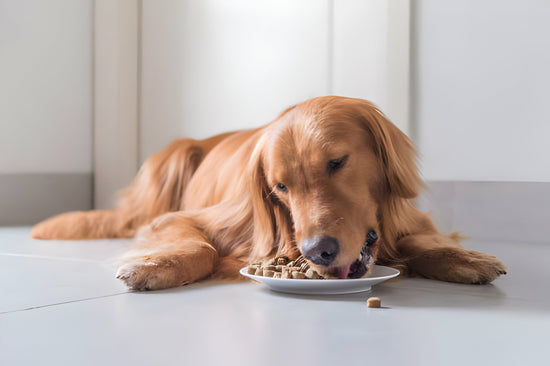
Enter pincode to check delivery date
As a pet parent, you want to ensure that your furry friend receives the best possible nutrition for a healthy and happy life.
A balanced dog diet chart is essential for maintaining your dog's overall well-being; whether a tiny Pomeranian or a majestic Labrador , they all need a balanced diet.
This comprehensive guide will provide you with valuable insights into the nutritional requirements of dogs and feeding guidelines, which will equip you with the knowledge to create a dog diet chart that keeps your dog's tail wagging healthily!

Think of a balanced diet as the foundation for your dog's long, healthy life . It provides the essential building blocks for strong bones, a shiny coat, and boundless energy. It also helps maintain a healthy weight, supports a strong immune system, and promotes overall well-being.
By providing your dog with the proper nutrients, you can prevent various health issues and ensure they maintain a healthy lifestyle.
A healthy diet can help prevent obesity, diabetes, heart disease, and other health concerns.
The right balance of nutrients promotes healthy digestion and gut bacteria, leading to fewer tummy troubles.
A well-nourished dog will have the energy to play, explore, and live life to the fullest!
From a shiny coat and healthy skin to strong muscles and bright eyes, a balanced diet reflects your dog's overall health and happiness.

Adult dogs require a variety of essential nutrients to maintain optimal health. These include:
Protein is essential for building and repairing muscles, tissues, and organs. It also plays a vital role in the production of enzymes and hormones. It maintains muscle mass, supports the immune system, and helps in aiding tissue repair.
Fats provide energy and aid in the absorption of fat-soluble vitamins like vitamins A, D, E, and K. They also contribute to healthy skin and coat, providing insulation to the body.
Carbohydrates are a primary source of energy for dogs and support various bodily functions, including brain function.
Vitamins play crucial roles in maintaining a strong immune system, help in preventing blood clots, promoting healthy growth, and supporting various metabolic processes.
Minerals are essential for bone and teeth development, muscle function, and overall metabolic processes, including enzyme production. Sometimes, a regular diet is incomplete without the addition of supplements to increase the intake of calcium and phosphorus.
Dogs need water to stay healthy, just like humans. Water supports digestion, circulation, and temperature regulation. Make sure your dog always has access to fresh water.


If you prefer to prepare homemade meals for your dog, it's essential to follow specific guidelines to ensure your dog receives a well-balanced diet.

When creating homemade dog food, aim for a balanced ratio of protein, carbohydrates, and healthy fats. A general guideline is:
Additionally, include essential vitamins and minerals through whole food sources or dog supplements.
Feeling adventurous? You can create balanced homemade dog food using fresh, high-quality ingredients and include a food topper . Here are a few super healthy homemade dog food recipes to try:
Ground chicken, brown rice, carrots, green beans, and a sprinkle of flaxseed. You can also add green leafy vegetables like cabbage or cauliflower which have high water content and are rich in vitamin B, but avoid cooking them.
Shredded chicken, sweet potatoes, spinach, and a touch of coconut oil.
Lean ground mutton, quinoa, peas, and a blend of fresh herbs.
Supertails Tip: Leguminous vegetables are protein-rich and contain B complex vitamins. Some may have anti-nutritional factors, but heat treatment can destroy them.

While creating a balanced diet for your dog, it's essential to include nutrient-dense foods and avoid potentially harmful ones.
Supertails Vet Tip: Meats like chicken can be incorporated in the daily diet of your dogs, they provide the apt amount of protein requirement. Also the addition of supplements helps in replenishing the lost nutrients.

To create a well-balanced meal for your dog, consider the following portion recommendations:
Supertails Tip : Herbs like mint, parsley, turmeric, and ginger can be added in small quantities for their potential health benefits. Adding fresh herbs to your dog's meals can provide additional nutritional benefits and flavour.

To calculate the appropriate portions for your dog, consider their weight, activity level, and any specific dietary needs.
Adjust the portions based on your dog's individual needs and monitor their weight and body condition regularly.

Make sure your furry buddy gets two meals per day and treats should also be included as a part of their diet.
The most common feeding schedule for adult dogs is two meals per day, which can be 8-12 hours intervals. This schedule helps regulate their metabolism, maintains steady energy levels, and aids digestion.
While two meals per day are generally recommended, some dogs may do better with a slightly different schedule based on their individual needs and lifestyle. For example:
When establishing a feeding schedule, it's essential to consider your dog's daily routine and activity levels. Avoid feeding immediately before or after long hours of exercise, as this can increase the risk of bloating or tummy troubles.
You can also include dog treats as part of their diet, but they should not be very frequent and should be limited. These treats can also be part of your training process for your canine companion.

Providing your adult dog with a balanced and nutritious diet is essential for maintaining overall health, vitality, and longevity. By understanding the nutritional requirements, adopting a well-balanced recipe for adult dogs and following appropriate feeding guidelines, you can ensure your canine companion receives the necessary nutrients to thrive.
Always consider factors such as breed size, age, activity level, and any specific health conditions when determining the appropriate diet and portions for your adult dog. Remember to consult your veterinarian for personalised recommendations and guidance on your adult dog's dietary requirements, as their needs may change as they age.
By understanding your dog's specific needs and providing them with the proper nutrients, you can contribute to their long-term well-being and create a lasting bond filled with tail wags and happy barks!
Q: Can I feed my dog homemade food?
A: Yes, you can! Homemade food is just as good as commercial dog food. Just ensure it meets their nutritional needs. Consult with your vet for guidance.
Q: Are there specific foods I should avoid giving my dog?
A: Yes, certain foods like chocolate, onions, and grapes can be toxic to dogs. Refer to our list of foods not recommended for dogs.
Q: Can I feed my dog a vegetarian or vegan diet?
A: While it is possible to feed your dog a vegetarian or vegan diet, it requires careful planning and supplementation to ensure they receive all the necessary nutrients. It's recommended to consult with a veterinary nutritionist to create a balanced, meatless diet for your dog.
Q: How do I transition my dog to a new diet?
A: To transition your dog to a new diet, it's best to do it gradually over 5-7 days. Start by mixing a small amount of the new food with their current food, and gradually increase the ratio until you've fully transitioned to the new diet.
Q: How can I tell if my dog is getting the right amount of food?
A: Monitor your dog's body condition score and weight. A healthy dog should have a visible waistline when viewed from above and from the side. If your dog is gaining or losing weight, adjust the portions accordingly.
Q: Can I feed my dog table scraps?
A: It's generally not recommended to feed your dog table scraps, as they can be high in fat, salt, and other ingredients that may harm your dog's health. Stick to a balanced, complete dog food and limit treats to no more than 10% of their daily caloric intake.




Why Choose Royal Canin Dog Food? Happy & Healthy Dogs

10 Best Dog Food Brands in India in 2024

Craft Your Pup's Perfect Diet Chart: A Puppy Nutrition Guide

How to pick the right food for your dog

Your Pup's Feeding Guide: Nourishment for Every Life Stage
The Benefits of Wet Dog Food Over Dry Dog Food